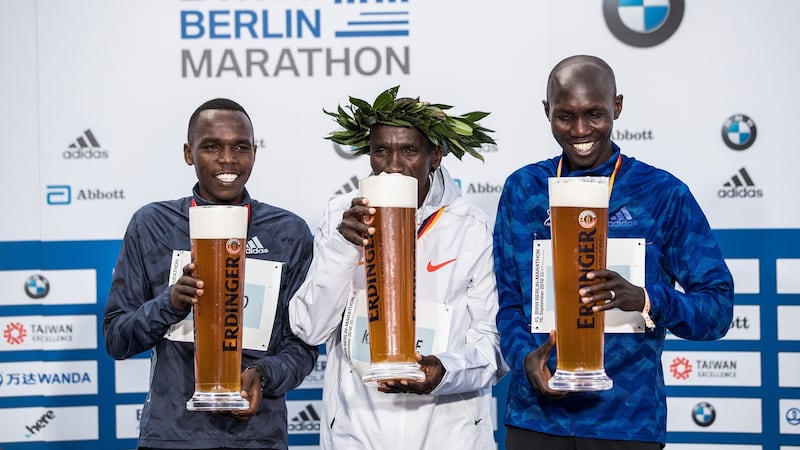When Eliud Kipchoge woke to a dazzling Monday morning in Berlin he was greeted with global headlines lauding him as a “long-distance Usain Bolt” and “the fastest man in the world”. No wonder, given that he had just “pulverised” – as Marca put it – the marathon world record by 78 seconds.
According to Die Welt, the Kenyan had also performed another feat of wizardry by contradicting the late Czech runner Emil Zatopek, in 1954 the first man to break the 29-minute barrier in the 10,000m and a visionary who famously said that "fish float, birds fly, and humans run". The paper insisted: "The 33-year-old did not run. He flew to a new world best."
As Kipchoge soared across the line in 2hr 01min 39sec, even sober minds began to entertain the fantastical. His time, after all, was just 100sec from the holy grail of distance running: the sub-two-hour marathon. Suddenly the pipe dream did not look so potty.
Certainly Kipchoge, who ran 2:00.25 in Monza last year as part of the Nike Breaking2 project – although it did not count under official rules as pacers were subbed in and out of the race – thinks it is possible. “It is not rocket science to break this barrier,” he insisted. “You simply have to believe in it. And you need a great team that believes in it and in you, the perfect shoes, and to be stronger than any runner before. Then everything is possible.”
Intriguingly, some scientists agree. "It is now a significant step closer," says Dr Michael Joyner, an expert in human performance at the Mayo Clinic in Minnesota. "We might see something like a Tiger Woods effect – when he arrived on the golfing scene he was a quantum leap forward, yet eventually there was a catch-up."
Joyner, who wrote an academic paper 27 years ago suggesting that it was physiologically possible to run a 1:58 marathon, says that if more athletes concentrate on the distance earlier in life it could also make a difference. “There was an 18-year-old Ethiopian who ran the 5,000m in 12:43 last month,” he says. “That’s 10 seconds faster than Mo Farah’s personal best. What might he do over 26.1 miles in a few years?”
Others, however, are more sceptical. The highly respected sports scientist Dr Ross Tucker believes that sub-two is "probably at least 15-20 years away" although there is a substantial caveat. He is unsure how much improved shoe technology and science helped Kipchoge – and how future tech boosts could further improve times.

“What is remarkable about Kipchoge is his ability to run at a high relative speed for so long,” says Tucker. “But we don’t know how much of his world record is tech-driven. Was it the athlete or his shoes that made the difference? It muddies the waters.” Like most top distance athletes sponsored by Nike, Kipchoge runs in Vaporflys, which contain a highly controversial carbon-fibre plate in their soles, and are claimed to improve times by 1 per cent over the next speediest shoe.
On Sunday Kipchoge's manager, Jos Hermans, cited another factor – an energy drink made by the Swedish company Maurten. Not only does it contain more carbohydrates than other such drinks but, crucially, it also forms a hydrogel when it reaches the stomach – thus supplying more energy during a marathon without causing gastrointestinal problems.
“So is that the shoe? The carb-drink? The mindset? I am not sure,” says Tucker. “But if it is the first two then the sub-two is a lot closer than you would think. Because all it will take is a similar step-up in technology as we have seen in recent years.
“However if technology is not a massive factor, then a sub-two is a lot further away because the physiology of humans isn’t going to change as quickly.”
A lot depends on how much of a phenomenon Kipchoge is. Remember Paula Radcliffe’s women’s marathon record was set in 2003 yet still stands today.
Meanwhile Mark Burnley, a sport scientist at the University of Kent who specialises in high performance, says the "big three" physiological parameters of VO2max, lactate threshold and running economy remain the biggest limiting factors in going under two hours.
“To take a car analogy, maximal oxygen consumption [VO2max]is the size of the engine, oxygen consumption [VO2]is how much the accelerator pedal is being pressed down at any one time, and the lactate threshold is the rev limiter,” he says. “Although you can go above this point, the engine doesn’t like it and the car will break down [fatigue]eventually.
“Meanwhile running economy is a measure much like miles per gallon. The more economical the engine the further a given fuel load [muscle glycogen] can take you. Combining all of these factors determines how fast, and how long, an athlete can run for. Theoretically, the maximum speed a runner can sustain is given by a thing called the critical speed. Above that, your physiology goes haywire. Or, to continue the car analogy, bits of trim fall off until you blow a gasket and your vehicle falls to bits.”
Burnley says that critical speeds of just over 21km per hour are possible in 10,000m athletes, which is sub-two-hour pace, but it places a severe strain on their carbohydrate reserves and the probability of hitting the wall is very high.
For Kipchoge, however, walls are something over which to joyously leap. “No human is limited,” he says. “Everything is possible, and records are there to be broken.” Yes, even his remarkable one. – Guardian service




















